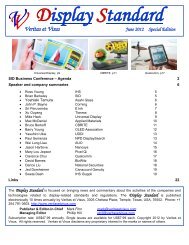Create successful ePaper yourself
Turn your PDF publications into a flip-book with our unique Google optimized e-Paper software.
<strong>Veritas</strong> <strong>et</strong> <strong>Visus</strong> <strong>Display</strong> <strong>Standard</strong> February 2009<br />
Wireless connectivity will offer increased options for home theater and optical versions of HDMI cables will allow<br />
remoting of the TV screens beyond the current 10-foot limitation of HDMI cables.<br />
Concerning the environmental issues, presently LCDs are less energy efficient than CRTs. (Per the California<br />
Energy Commission, LCDs use 0.27 Watts per square inch of screen vs. 0.23 for a CRT and 0.36 for a plasma).<br />
However, the LCDs could become significantly more efficient. Where CRT generates light that is the image, an<br />
LCD starts off with white light from another source and throws away light in successive layers in the device, until<br />
the desired image is generated. Less than 6% of the light that goes into an LCD comes out as part of the image.<br />
Various companies are working on ways to increase the optical efficiency. In particular, one of the first things that<br />
happen in the optical path of an LCD is that the light passes through a polarizer that throws away half the light.<br />
Agoura Technologies is developing a polarizer that recycles most of this light instead of throwing it away. The<br />
highly secr<strong>et</strong>ive Holox Technologies is working on a technique that does away with one of the layers entirely. The<br />
biggest issue for both Agoura and Holox is that in addition to the downturn causing a suspension in new factory<br />
capacity, it is also causing a downturn in venture capital funding of new technology. The Agoura, Holox, and many<br />
other developing technologies are not likely to be mature enough to be applied to consumer TV s<strong>et</strong>s by the time the<br />
mark<strong>et</strong> turns around.<br />
Additionally, CRTs contain a lot of lead. While some in the EPA freely admitted that lead bound up in a glass is<br />
“there for millennia”, standard hazardous waste disposal rules require that the product be ground up and mixed with<br />
cement, making it much more bio-available. Many communities charge a special disposal fee for CRTs and these<br />
fees will only grow as time passes. Given the Green climate, if the industry were to develop a comprehensive<br />
system to collect and dispose of CRTs with the purchase of a new LCD TV, this would be an attractive package for<br />
the consumer rather than having to pay a higher cost at some future date to have the CRT put in a hazardous waste<br />
landfill. (Some corporations have already disposed of their CRT monitors for just this reason.) The expense of such<br />
a program would depend on what is done with the CRTs. According to EPA’s 2008 Electronics Waste Management<br />
in the United States Report, in 2007, “An estimated 99 million televisions had accumulated in storage, piling up in<br />
people’s clos<strong>et</strong>s, basements, and garages… In 2007, Americans discarded nearly 27 million TVs, recycling<br />
approximately 18%.”<br />
One area that may be a possibility is renewable energy. Even in the best locations the duty cycle for wind and solar<br />
energy is only about 20%, so, almost by definition, the renewable energy mark<strong>et</strong> creates an expanded mark<strong>et</strong> for<br />
batteries. Until advanced fuel cell technology is ready having a lot more local power storage in the form of<br />
lead/acid batteries is not such a bad idea for the nation’s shaky power grid. The batteries already have a very high<br />
recycle rate and if you can keep the lead out of a landfill, it minimizes both expense and future liability. Some years<br />
ago, Corning used to pay a battery maker to dispose of the lead bearing waste that accumulated in its CRT glass<br />
making furnaces. After the company implemented a recycling program, the same company offered to pay for the<br />
waste. Per the law at the time, selling a product as a raw material severed any future liability where some liability is<br />
r<strong>et</strong>ained if the material is transferred as a waste. So, the sale of the waste both saved the company money and<br />
severed any liability with respect to that waste stream. If a mark<strong>et</strong> is created for the lead-bearing CRT waste and it<br />
can be sold rather than disposed of, this would generally benefit the industry. Interestingly, in the 1990s when the<br />
US CRT tube industry was offered a choice b<strong>et</strong>ween a new glass composition that fixed the browning issue and one<br />
that made it easier to recycle old CRTs into new ones, they picked recycling. Later, the LCD glass was also<br />
modified to facilitate recycling; the Corning “Eagle” composition eliminated the arsenic in the glass.<br />
A government lobbying effort which I subsequently lead, convinced the EPA of the need to make exceptions for<br />
CRT (http://yosemite.epa.gov/opa/admpress.nsf/b1ab9f485b098972852562e7004dc686/6be0e9642cdeac198525662f0066b993?OpenDocument)<br />
waste handling in order to facilitate recycling. A similar effort to require current lead users to pay fair mark<strong>et</strong> value<br />
for the lead content of CRT glass would further encourage recycling.<br />
115






